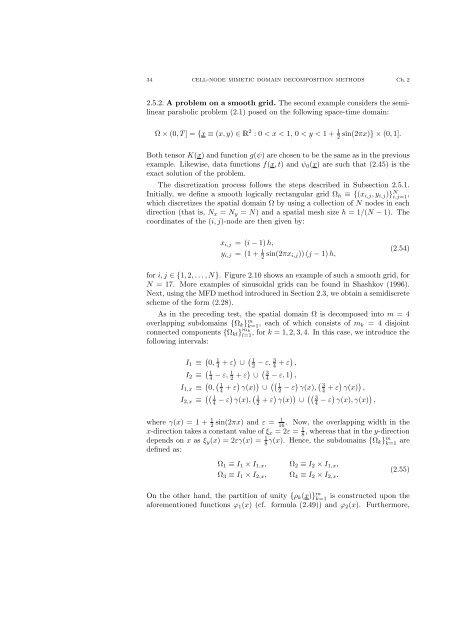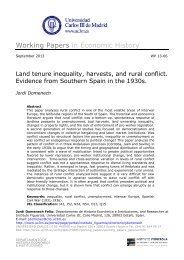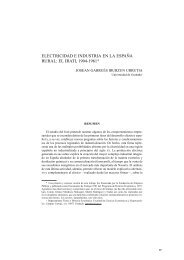Métodos miméticos de pasos fraccionarios - E-Archivo - Universidad ...
Métodos miméticos de pasos fraccionarios - E-Archivo - Universidad ...
Métodos miméticos de pasos fraccionarios - E-Archivo - Universidad ...
Create successful ePaper yourself
Turn your PDF publications into a flip-book with our unique Google optimized e-Paper software.
34 cell-no<strong>de</strong> mimetic domain <strong>de</strong>composition methods Ch. 2<br />
2.5.2. A problem on a smooth grid. The second example consi<strong>de</strong>rs the semilinear<br />
parabolic problem (2.1) posed on the following space-time domain:<br />
Ω × (0, T ] = {x ≡ (x, y) ∈ R 2 : 0 < x < 1, 0 < y < 1 + 1<br />
2 sin(2πx)} × (0, 1].<br />
Both tensor K(x) and function g(ψ) are chosen to be the same as in the previous<br />
example. Likewise, data functions f(x, t) and ψ0(x) are such that (2.45) is the<br />
exact solution of the problem.<br />
The discretization process follows the steps <strong>de</strong>scribed in Subsection 2.5.1.<br />
Initially, we <strong>de</strong>fine a smooth logically rectangular grid Ωh ≡ {(xi,j, yi,j)} N i,j=1 ,<br />
which discretizes the spatial domain Ω by using a collection of N no<strong>de</strong>s in each<br />
direction (that is, Nx = Ny = N) and a spatial mesh size h = 1/(N − 1). The<br />
coordinates of the (i, j)-no<strong>de</strong> are then given by:<br />
xi,j = (i − 1) h,<br />
yi,j = (1 + 1<br />
2 sin(2πxi,j)) (j − 1) h,<br />
(2.54)<br />
for i, j ∈ {1, 2, . . . , N}. Figure 2.10 shows an example of such a smooth grid, for<br />
N = 17. More examples of sinusoidal grids can be found in Shashkov (1996).<br />
Next, using the MFD method introduced in Section 2.3, we obtain a semidiscrete<br />
scheme of the form (2.28).<br />
As in the preceding test, the spatial domain Ω is <strong>de</strong>composed into m = 4<br />
overlapping subdomains {Ωk} m k=1 , each of which consists of mk = 4 disjoint<br />
connected components {Ωkl} mk<br />
l=1 , for k = 1, 2, 3, 4. In this case, we introduce the<br />
following intervals:<br />
I1 ≡ ( 0, 1<br />
4 + ε) ∪ ( 1 3<br />
2 − ε, 4 + ε) ,<br />
I2 ≡ ( 1<br />
4<br />
− ε, 1<br />
2 + ε) ∪ ( 3<br />
4 − ε, 1) ,<br />
I1,x ≡ ( 0, ( 1<br />
4 + ε) γ(x) ) ∪ (( 1<br />
2 − ε) γ(x), ( 3<br />
4 + ε) γ(x) ) ,<br />
I2,x ≡ (( 1<br />
4 − ε) γ(x), ( 1<br />
2 + ε) γ(x) ) ∪ (( 3<br />
4 − ε) γ(x), γ(x) ) ,<br />
where γ(x) = 1 + 1<br />
1<br />
2 sin(2πx) and ε = 16 . Now, the overlapping width in the<br />
x-direction takes a constant value of ξx = 2ε = 1<br />
8 , whereas that in the y-direction<br />
<strong>de</strong>pends on x as ξy(x) = 2εγ(x) = 1<br />
8γ(x). Hence, the subdomains {Ωk} m k=1 are<br />
<strong>de</strong>fined as:<br />
Ω1 ≡ I1 × I1,x, Ω2 ≡ I2 × I1,x,<br />
Ω3 ≡ I1 × I2,x, Ω4 ≡ I2 × I2,x.<br />
(2.55)<br />
On the other hand, the partition of unity {ρk(x)} m k=1 is constructed upon the<br />
aforementioned functions φ1(x) (cf. formula (2.49)) and φ2(x). Furthermore,

















